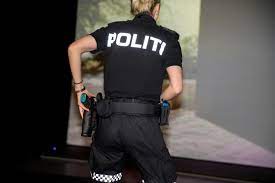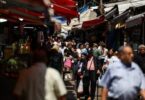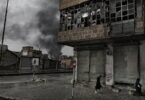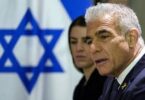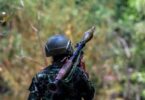OSLO (AFP): Revolvers in hand, they advance slowly down the hallway past the panicked and wounded witnesses before the armed suspect suddenly comes into view, about to kill a man cowering on the floor.
To shoot or not? It’s a split-second decision.
The gun is a laser training weapon and the mass shooting a scene projected on an interactive screen.
At the Oslo police academy, housed in an imposing red-brick building, police cadets are learning how to handle an active shooter.
In the United States the numbers killed by police hit a new record last year — at least 1,194 dead according to Mapping Police Violence, or more than three a day. In Norway police are rarely involved in fatal shootings.
“There’s no ‘spray and pray’ here,” says instructor Espen Olsvik.
“The shot has to be justified. And you don’t empty your clip in the hopes of eventually hitting the target,” he adds.
Cadets are debriefed after every practice round on the simulator. Did you have to open fire on the extremist? At what exact moment? How do you neutralise a suspect wearing a bulletproof vest?
Comparing the United States, population more than 330 million, and Norway, population 5.4 million, can be unfair.
The former struggles with social inequalities and racial tensions, the latter is sparsely populated, wealthy and egalitarian.
Norway has been largely spared such tensions despite rising immigration as stiff entry rules and a strong labour market mean most immigrants can be self-sufficient.
And there is also a huge difference in how the two countries train their law enforcement officers.
In the US, some states require only a few weeks of instruction in order to become a cop.
According to CNN, basic training in Louisiana is completed in 360 hours, significantly less than the 500 hours required to become a licensed manicurist.
In the Scandinavian country, a police officer graduates from the academy after three years of studies that include psychology, law and ethics, in addition to standard police work.
Not the Wild West
Getting accepted into the academy is difficult, with between 3,000 and 3,500 young people vying each year for the 500 spots.
The academy selects only the top candidates.
“We have criteria like being a good team worker, open-minded and analytical capacity”, says the head of the academy’s bachelor department Philip Christopher Tolloczko.
“We don’t want any Wild West cowboys here”, he says.
On the contrary, “at an operational level, we spend a lot of time practising how to de-escalate situations”.
Tellingly, 80 percent of Norwegians say they have confidence in the police force.
As in Britain, the question of whether Norway’s police should be armed at all times is regularly debated.
While Norwegian police are normally unarmed — their service weapons are locked in their patrol cars — they can be ordered to carry weapons temporarily for security reasons.
‘Temporarily’ is sometimes a relative concept — after a fatal shooting on the sidelines of Oslo’s Pride festival in June 2022, police were armed for 237 days until the order was dropped on Monday.
“It’s a problem if the police militarise”, says former member of parliament and ex-Oslo mayor Michael Tetzschner.
“If police adopt a military mentality, I fear that they’ll lower the bar for the use of firearms”.
In a country with a small population, the numbers are modest: five people have been killed by police since the start of 2020.
Still, that’s almost double the three who were killed during the entire previous decade.
Words instead of weapons
At the Oslo police academy, Anders Haugerud looks on as first-year cadets, training in a staged apartment setting, try to calmly determine the identity of a man who thinks he is the king or a woman suffering a psychotic episode.
The roles are being played by hired actors.
“You have to have the gift of communication”, says Haugerud, a police chief who spent 20 years on patrol.
The only weapon he ever used, he says, was his baton, once.
“Communication, humility, confidence… We also teach students to apologise when they make a mistake”, Haugerud says.
Norway’s police was heavily criticised for its slow response in the devastating July 22, 2011, twin attacks.
Right-wing extremist Anders Behring Breivik killed 77 people, mostly teens. He stalked them before opening fire over 72 long minutes on the small island of Utoya.
The force now puts more emphasis on handling crisis situations.
But above all else, notes Tore Bjorgo, a researcher who teaches at the academy, “In the Norwegian police, the most important weapon is your words.”

